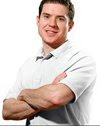- Flexibility is the length to which a muscle can be stretched and held, while mobility is the length that a muscle can be stretched during movement.
Ideally, in golf, a muscle should have both flexibility and mobility, but mobility takes precedent because this is where injury often happens. If a muscle does not have proper mobility, extreme movements (i.e. the golf swing) stretch the muscle beyond its current level of mobility. Dynamic stretching is best performed prior to activity and effectively prepares the body for activity by exciting the nervous system. Static stretching is best performed post-exercise and enhances recovery following activity by desensitizing the nervous system. Using both of these types of stretching will help you keep your muscles long and make you golf movements more powerful.



